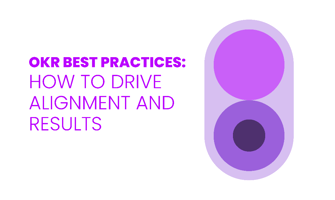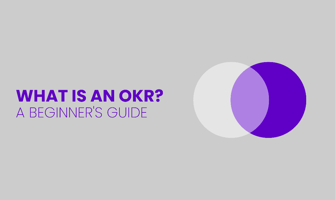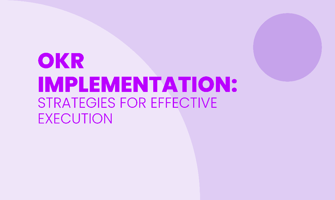OKRs (Objectives and Key Results) are a powerful goal-setting framework that helps organizations...
How to Create an Effective OKR Planning Process
The OKR planning process is a structured approach to setting and achieving goals within an organization. It is important because it helps align everyone with the same objectives, ensures measurable progress, and drives overall success.
This article outlines the steps to develop a successful OKR planning process. By understanding and implementing these steps, you set clear objectives, define measurable key results, and create a cohesive strategy that drives organizational success.
Interested in getting started with OKRs? Read "What is an OKR? A Beginner's Guide."
Understanding the Importance of OKRs
OKRs, or Objectives and Key Results, are a goal-setting framework that helps organizations define and track their goals. The main purpose of OKRs is to provide clear direction and measure progress effectively, ensuring everyone in the organization works towards the same goals.
Objectives: Specific, important, and actionable goals aligned with the organization's mission.
Key Results: Measurable outcomes that show progress toward the objectives.
Implementing OKRs can greatly benefit organizations by fostering accountability, improving focus, and driving results. 83% of companies surveyed believe that OKRs have a positive impact on their organization, with nearly one-third fully agreeing. This shows how effective OKRs are in achieving company goals.
Unlike other goal-setting frameworks, OKRs emphasize transparency, alignment, and measurable outcomes, linking individual efforts to the organization's broader goals.
Steps for an Effective OKR Planning Process
1. Understanding the OKR Framework
The OKR framework is a goal-setting system that helps organizations define and track objectives and their outcomes. It consists of two main components:
Objectives: These are specific, significant, and actionable goals you want to achieve. Objectives should be clear, inspirational, and aligned with the organization's mission.
Key Results: These are measurable outcomes that indicate progress toward your objectives. Key Results should be specific, time-bound, and quantifiable. They act as indicators that show how close you are to achieving your objective.
The framework works by setting clear objectives and breaking them down into smaller, measurable key results. This process ensures that everyone in the organization knows what the goals are and how progress will be measured.
2. Setting Clear and Ambitious Objectives
To set effective objectives, follow these steps:
Identify the Goal: Determine what you want to achieve. The goal should align with the overall mission and strategy of the organization.
Make it Clear and Specific: Ensure that the objective is easily understood and leaves no room for ambiguity. It should address a particular area of improvement or achievement.
Ensure it's Ambitious but Achievable: Set a goal that pushes the organization to strive for excellence but is also realistic enough to be attainable.
Align with Broader Goals: Make sure the objective is in line with the broader goals of the organization. This ensures coherence and focus across different levels of the organization.
For example, an objective could be "Increase market share in the European region by 20% within the next fiscal year." This objective is clear, specific, ambitious, and aligned with broader organizational goals.
![]()
3. Defining Measurable Key Results
To define measurable key results, follow these steps:
Break Down the Objective: Start by breaking down the objective into smaller, actionable components. These should be specific outcomes that will lead to achieving the overall objective.
Ensure Specificity: Each key result should clearly define what is to be achieved without ambiguity.
Make it Measurable: Quantify the key result so that progress can be tracked objectively. Use metrics and data to define success.
Set Realistic Targets: While the key results should be challenging, they should also be attainable within the given timeframe.
Ensure Relevance: Each key result should directly contribute to the objective. It should be relevant and have a clear impact on achieving the goal.
Time-bound: Assign a clear deadline to each key result to maintain focus and urgency.
For example, if the objective is to increase market share, a key result could be "Acquire 1,000 new customers in the European region by Q2." This key result is specific, measurable, achievable, relevant, and time-bound.
4. Aligning OKRs Across the Organization
Aligning OKRs ensures that all teams work towards common goals, enhancing overall coherence and efficiency. Here’s how to align OKRs:
Cascading OKRs: Break down top-level objectives into smaller, team-specific objectives. Each team should have objectives that support the higher-level goals.
Regular Check-ins: Hold frequent meetings to review progress and adjust OKRs as needed. This keeps everyone on track and aligned.
Transparency: Share OKRs across the organization so everyone is aware of the goals and progress. This fosters a sense of unity and purpose.
When a sales team’s OKR to "increase sales by 10%" aligns with the company’s objective to "expand market share," it ensures coordinated efforts. This alignment leads to better resource allocation and more effective strategies.
5. Involving Stakeholders in the Planning Process
Engaging stakeholders is important for the success of the OKR process. Here’s how to involve them:
Leadership Role: Leaders set the vision and strategic direction. Their involvement ensures that OKRs are aligned with the organization’s mission and priorities. They also motivate and guide teams throughout the OKR process.
Engage Employees and Teams: Engaging employees fosters a sense of ownership and accountability. When team members contribute to setting their OKRs, they are more committed to achieving them.
Gather Input and Feedback: Use workshops, brainstorming sessions, surveys, and feedback to gather input from employees and other stakeholders. This ensures that the OKRs are relevant and attainable.
By involving stakeholders in the planning process, you create a sense of ownership and commitment, which increases the likelihood of achieving your goals. Regular updates and reviews keep everyone informed about progress and encourage ongoing feedback.
![]()
6. Creating an OKR Timeline
Creating an effective OKR timeline involves deciding the period for which the OKRs will be set and tracking progress through milestones and checkpoints.
Quarterly OKRs allow for more flexibility and responsiveness to changes, providing frequent opportunities to review and adjust goals based on current performance and market conditions.
Annual OKRs are suitable for long-term objectives but should be complemented with quarterly milestones to ensure ongoing progress and adaptability.
Set annual or quarterly objectives.
Break these objectives into smaller, manageable milestones.
Establish regular checkpoints to review progress, celebrate achievements, and identify areas that need adjustment.
Ensure the timeline is realistic and achievable, considering available resources.
Avoid overloading teams with too many objectives at once.
Use project management tools to keep track of milestones and deadlines.
7. Aligning OKRs with KPIs
Aligning OKRs with KPIs (Key Performance Indicators) ensures cohesive performance tracking and goal achievement. OKRs focus on setting ambitious goals and defining measurable outcomes, while KPIs are metrics used to evaluate ongoing performance and success.
Use KPIs to inform the creation of Key Results. For example, if a KPI is customer satisfaction, a Key Result might be "Increase customer satisfaction score from 70% to 85%."
Regularly review KPIs to adjust OKRs as needed, ensuring they remain relevant and aligned with overall performance metrics.
Align department-specific KPIs with broader organizational OKRs to ensure coherence and focus.
Use performance dashboards to visualize the alignment between OKRs and KPIs.
8. Review and Adjust OKRs Regularly
Regular reviews and adjustments are important to maintaining the effectiveness of OKRs. Continuous review helps track progress and ensures that objectives remain relevant. Reviews provide an opportunity to celebrate successes and address challenges.
Schedule regular review meetings (e.g., monthly or quarterly).
Assess the progress of each Key Result and overall objectives.
Involve relevant stakeholders in the review process to gather comprehensive feedback.
Be flexible in modifying objectives and key results based on performance data and feedback.
Document learnings from each review session to inform future OKR planning cycles.
Use feedback loops to ensure continuous improvement.
9. Tools and Techniques for OKR Tracking
Using the right tools and techniques can significantly enhance OKR tracking and management.
Digital tools like spreadsheets, dedicated OKR management platforms, and project management tools can streamline OKR tracking.
Use dashboards to visualize progress and make data-driven decisions.
Implement regular check-ins and updates to monitor progress and address issues promptly.
Encourage transparency and collaboration by sharing OKR progress across the team.
Use tools like 180ops which is a revenue intelligence tool that integrates with CRM, customer service, and sales data, 180ops helps track and analyze OKRs by providing actionable insights for better decision-making and aligning revenue-related objectives and key results with overall business goals.
Consider using OKR-specific software to automate tracking and reporting processes.
10. Addressing Common Challenges in OKR Planning
Identifying and overcoming common challenges can lead to a more effective OKR process. Typical challenges include setting unrealistic or overly ambitious goals, lack of alignment between team and organizational objectives, and insufficient engagement from employees and stakeholders.
Set realistic and achievable goals based on available resources and constraints.
Ensure alignment through regular communication and cascading OKRs.
Foster engagement by involving employees in the OKR-setting process and providing regular feedback.
Address misalignment issues by holding cross-functional meetings to ensure everyone is on the same page.
Provide training sessions to ensure all team members understand the OKR process and its importance.
Use clear and consistent communication to keep everyone informed and motivated.
11. Actionable Steps for Implementing OKRs
Implementing OKRs requires a structured approach and commitment to continuous improvement.
Set clear objectives by defining what you want to achieve at the organizational level.
Break down objectives into team and individual levels, ensuring alignment.
Define specific, measurable Key Results for each objective.
Communicate and engage all relevant stakeholders in the process.
Use tools and techniques to monitor progress.
Schedule regular reviews to assess progress.
Adjust OKRs as needed based on feedback and performance.
Start with a pilot program to test and refine the OKR process.
Foster a culture of transparency and accountability.
12. Best Practices for a Successful OKR Implementation
Start with a pilot program to test and refine the OKR process. Foster a culture of transparency and accountability. Provide training and support to ensure everyone understands the OKR framework.
Encourage continuous feedback and learning to improve the OKR process.
Use insights from past OKRs to set more effective goals in the future.
Adapt and evolve the OKR process to meet changing organizational needs.
Hold regular training sessions to keep everyone updated on best practices and new techniques.
Create a support system where team members can share their experiences and learn from each other.
By following these steps and implementing best practices, you can create an effective OKR planning process that drives alignment, engagement, and measurable progress toward your organizational goals.
![]()
Conclusion
Having a clear OKR planning process is key for keeping everyone in an organization on the same page and working towards shared goals. By setting clear objectives, defining measurable key results, and regularly checking progress, teams can stay focused and improve continuously.
Following an effective OKR planning process helps organizations set and reach their goals better, encouraging teamwork and growth. Follow these steps to help your team succeed and achieve consistent success.
FAQs
How do you start the OKR planning process?
To start the OKR planning process, identify the organization's strategic goals and break these down into specific, actionable objectives. Engage leadership and key stakeholders to ensure alignment and commitment. Begin with a pilot program to test and refine the process before full-scale implementation.
What are the steps involved in creating an OKR timeline?
Create an OKR timeline by deciding on the planning period (quarterly or annually), setting milestones and checkpoints, and establishing a schedule for regular reviews. Use project management tools to keep track of progress and ensure deadlines are met. Ensure the timeline is realistic and achievable, considering available resources.
How can you ensure alignment of OKRs across different levels of the organization?
Ensure alignment of OKRs by cascading top-level objectives into team-specific objectives. Hold regular check-ins to review progress and adjust as needed. Share OKRs transparently across the organization to maintain coherence and focus. Use performance dashboards to visualize alignment and progress.
What tools and techniques can enhance the OKR planning process?
Enhance the OKR planning process with digital tools like spreadsheets, OKR management software, and project management platforms. Use dashboards to visualize progress, implement regular check-ins to monitor progress, and encourage transparency and collaboration by sharing OKR progress across the team. Consider OKR-specific software for automation.
How should you review and adjust OKRs during the planning process?
Review and adjust OKRs by scheduling regular review meetings, assessing progress of each key result and overall objectives, and involving relevant stakeholders in the review process. Be flexible in modifying objectives and key results based on performance data and feedback. Document learnings to inform future OKR planning cycles.




